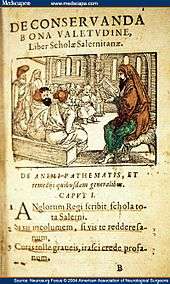Schola Medica Salernitana

The Schola Medica Salernitana (Italian: Scuola Medica Salernitana) was a medical school. Situated on the Tyrrhenian Sea in the south Italian city of Salerno, it was the most important source of medical knowledge in Western Europe at the time. Arabic medical treatises, both those that were translations of Greek texts and those that were originally written in Arabic, had accumulated in the library of Montecassino, where they were translated into Latin; thus the received lore of Hippocrates, Galen and Dioscorides was supplemented and invigorated by Arabic medical practice, known from contacts with Sicily and North Africa. As a result, the medical practitioners of Salerno, both men and women, were unrivalled in the medieval Western Mediterranean for practical concerns.
Overview

The school, which found its original base in the dispensary of a monastery founded in the 9th century, achieved its utmost splendour between the tenth and thirteenth centuries, from the last decades of Lombard power, during which its fame began to spread more than locally, to the fall of the Hohenstaufen. The arrival in Salerno of Constantine Africanus in 1077, marked the beginning of Salerno's classic period. Through the encouragement of Alfano I, Archbishop of Salerno and translations of Constantine Africanus, Salerno gained the title of "Town of Hippocrates" (Hippocratica Civitas or Hippocratica Urbs). People from all over the world flocked to the "Schola Salerni", both the sick, in the hope of recovering, and students, to learn the art of medicine.
Johannes (d.February 2, 1161) and Matthaeus Plantearius, possible father and son, resided in Salerno at this time when they apparently published their famous "Liber de Simplici Medicina" (a.k.a. "Circa Instans") which is first recorded in Salerno under their name early in the 13th Century. Subsequent incarnations — c.1480 now found in Brussels; and in the early 1500s, published in Paris with art by Robinet Testard and now found in both Paris and St.Petersburg — bore the name "Livre des simples medecines". Facsimiles with commentary for both editions have been published by Opsomer and Stearn (1984) and by Moleiro (2001).
Its fame crossed borders, as proved by the Salernitan manuscripts kept in many European libraries, and by historical witnesses. The twelfth or thirteenth-century author of the poem Regimen sanitatis Salernitanum gave a Salernitan provenance to his poem, in order to advertise his work and give validity to it. The school kept the Greek-Latin medical tradition going, merging it with the Arab and Jewish medical traditions. The meeting of different cultures led to a synthesis and the comparison of different medical knowledge, as evidenced by a legend that ascribes the foundation of the school to four masters: the Jewish Helinus, the Greek Pontus, the Arab Adela, and the Latin Salernus. In the school, besides the teaching of medicine (in which women too were involved, as both teachers and students), there were courses of philosophy, theology, and law.
The most famous female doctor and medical author at the school is Trotula or Trotula de Ruggiero who is accredited with several books on gynaecology and cosmetics, collectively known as The Trotula. De Passionibus Mulierum Curandorum was first published around 1100 AD and was a prominent text until a major revision by Louise Bourgoise, a midwife whose husband worked as assistant Ambrose Paré in the early 1600s.[1] A further 19 less definitive manuscripts by Trotula can be found in European libraries today.
Books made the Salernitan school famous. They had a strong start with the Pantegni, Constantine's translation and adaptation of the Al-malaki of Haly Abbas, ten volumes of theoretical medicine and ten of practical medicine. He had also translated a treatise on the ophthalmology of Hunayn bin Ishaq and the Viaticus of Ibn al-Jazzar. The most famous pharmacopeia of the Middle Ages, the Antidotarium Nicolai, also was written in the circles of the school.
Among the physicians who trained at the Schola Medica Salernitana is Gilles de Corbeil.
By the thirteenth century the medical school at Montpellier began to eclipse the Salernitan school.
See also
References
External links
| Wikimedia Commons has media related to Schola Medica Salernitana. |
- James L. Matterer, "Regimen Sanitatis Salernitanum"
- "Medieval Manuscripts in the National Library of Medicine: Salerno, the Mother of Medical Schools"
- "The Salerno Book of Health". Images from History of the School of Salernum, Harington, Sir John. 1920. With Introduction by Dr. Ian Carr]
- Lawn, Brian (1963). The Salernitan questions: an introduction to the history of Medieval and Renaissance problem literature. Clarendon Press. Retrieved 21 December 2012. at Questia
- "La Scuola Medica Salernitana. Gli autori e i testi". A cura di Danielle Jacquart e Agostino Paravicini Bagliani. Edizione nazionale la Scuola Medica Salernitana, Firenze, SISMEL - Edizioni del Galluzzo, 2007
- "Alphita". Edición crítica y comentario de Alejandro García González. Edizione nazionale la Scuola Medica Salernitana, Firenze, SISMEL - Edizioni del Galluzzo, 2007
- "Trotula: un compendio medievale di medicina delle donne". A cura di Monica H. Green; traduzione italiana di Valentina Brancone. Edizione nazionale la Scuola Medica Salernitana, Firenze, SISMEL - Edizioni del Galluzzo, 2009
- "Ps. Bartholomaeus Mini de Senis, Tractatus de herbis (Ms London, British Library, Egerton 747)". A cura di Iolanda Ventura. Edizione nazionale la Scuola Medica Salernitana, Firenze, SISMEL - Edizioni del Galluzzo, 2009
- "Terapie e guarigioni". A cura di Agostino Paravicini Bagliani. Edizione nazionale la Scuola Medica Salernitana, Firenze, SISMEL - Edizioni del Galluzzo, 2011